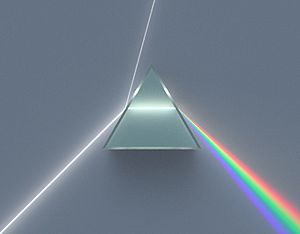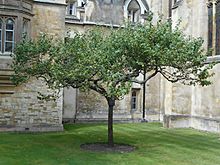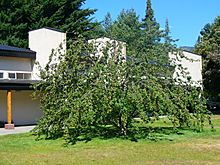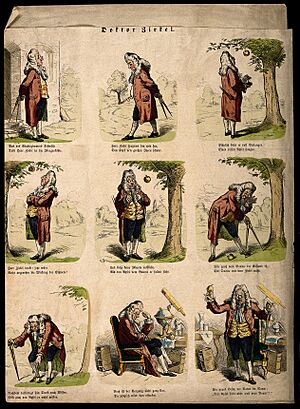Isaac Newton facts for kids
Quick facts for kids
Isaac Newton
|
|
|---|---|

Portrait of Newton at 46 by Godfrey Kneller, 1689
|
|
| Born | 4 January 1643 [O.S. 25 December 1642] |
| Died | 31 March 1727 (aged 84) [O.S. 20 March 1726] |
| Resting place | Westminster Abbey |
| Education | Trinity College, Cambridge (M.A., 1668) |
| Known for |
List
Newtonian mechanics
universal gravitation calculus Newton's laws of motion optics binomial series Principia Newton's method Newton's law of cooling Newton's identities Newton's metal Newton line Newton–Gauss line Newtonian fluid Newton's rings Standing on the shoulders of giants |
| Awards |
|
| Scientific career | |
| Fields |
|
| Institutions | |
| Academic advisors |
|
| Notable students | |
| Influences | |
| Influenced |
List
In the natural sciences and mathematics
|
| Member of Parliament for the University of Cambridge |
|
| In office 1689–1690 |
|
| Preceded by | Robert Brady |
| Succeeded by | Edward Finch |
| In office 1701–1702 |
|
| Preceded by | Anthony Hammond |
| Succeeded by | Arthur Annesley, 5th Earl of Anglesey |
| 12th President of the Royal Society | |
| In office 1703–1727 |
|
| Preceded by | John Somers |
| Succeeded by | Hans Sloane |
| Master of the Mint | |
| In office 1699–1727 |
|
| 1696–1699 | Warden of the Mint |
| Preceded by | Thomas Neale |
| Succeeded by | John Conduitt |
| 2nd Lucasian Professor of Mathematics | |
| In office 1669–1702 |
|
| Preceded by | Isaac Barrow |
| Succeeded by | William Whiston |
| Personal details | |
| Political party | Whig |
| Signature | |
 |
|
Sir Isaac Newton (born December 25, 1642 – died March 20, 1727) was a famous English mathematician, physicist, and astronomer. He was also an alchemist and theologian. Newton was a very important person in the Scientific Revolution and the Enlightenment. He helped us understand how the universe works.
Contents
Isaac Newton's Early Life
Isaac Newton was born on Christmas Day, December 25, 1642. This was in a small village called Woolsthorpe-by-Colsterworth in England. His father, also named Isaac Newton, had died before he was born.
When Isaac was three, his mother remarried and moved away. She went to live with her new husband, Reverend Barnabas Smith. Isaac was then cared for by his grandmother. He didn't like his stepfather and wished his mother hadn't remarried.
School Days at The King's School
From age twelve to seventeen, Isaac went to The King's School in Grantham. He learned Latin, Ancient Greek, and some basic math. When his stepfather died, his mother wanted him to become a farmer. But Isaac didn't like farming at all.
Luckily, Henry Stokes, the headmaster at The King's School, convinced Isaac's mother to send him back to school.
Studying at Cambridge University
In June 1661, Isaac Newton started studying at Trinity College at the University of Cambridge. His uncle, who had also studied there, suggested he go to Cambridge. In 1664, Isaac received a scholarship. This helped pay for his studies for four more years until he earned his Master of Arts degree.
In August 1665, Isaac got his Bachelor's degree. Soon after, the university closed temporarily because of the Great Plague. In April 1667, Newton returned to Cambridge. In October, he became a fellow of Trinity College.
His math professor, Isaac Barrow, was very impressed with Newton's work. In 1669, Newton took over Barrow's job as the Lucasian Professor of Mathematics. This was only one year after he got his Master's degree! In 1672, Newton became a Fellow of the Royal Society.
Newton's Amazing Discoveries
Newton used mathematics to explain how the universe works. He created laws of motion and gravity. These laws are like math rules that explain how objects move when a force pushes or pulls them.
In 1687, Isaac published his most famous book, Principia. In this book, he explained three basic laws of motion. He also shared his idea, or theory, about gravity. Gravity is the force that makes things fall down. For example, if a pencil falls off a desk, it lands on the floor, not the ceiling.
Newton also used his laws to show that planets orbit the sun in oval shapes, not perfect circles. He also discovered diffraction, which is how light spreads out. This led him to make big discoveries in physics.
Isaac Newton was a brilliant scientist and inventor. He made huge contributions to physics, mathematics, and optics. Here are some of his most famous inventions and discoveries:
- Newton's laws of motion: These laws are the basis for how we understand movement. They explain how an object's motion is connected to the forces acting on it.
- Law of universal gravitation: This theory says that all objects in the universe pull on each other with a gravitational force. It explained why planets orbit the sun.
- Reflecting telescope: Newton invented a telescope that used a curved mirror to focus light. This design avoided blurry colors and could magnify things 40 times! Most large telescopes today use a similar design.
- Calculus: Newton invented calculus, a major breakthrough in mathematics. It's used in many areas of science and engineering.
- Perfect coin: Newton worked at the Royal Mint, which made coins. He developed a way to make coins that was harder to copy, helping to stop fake money.
- Optics: Newton studied how light works. He discovered that a prism can split white light into all the colors of the rainbow. This helped us understand color.
- Shape of orbits: Newton also studied the shapes of orbits. He was shy about sharing his work at first, but his discoveries were very important.
- The reflecting sextant: This tool was used to measure angles between objects, like the sun and the horizon. It was very useful for navigation at sea.
Isaac Newton's discoveries changed the world. They continue to inspire scientists today.
Newton's Three Laws of Motion
Here are Newton's three laws of motion:
- The First Law (Law of Inertia)
- This law says that an object will stay still, or keep moving in a straight line at a steady speed, unless a force pushes or pulls it. Imagine a rocket. It won't move unless something pushes it. It's harder to imagine that an object will keep moving without help. But if a rocket is flying and its engine stops, it will keep going until something else stops it. This tendency to stay still or keep moving is called inertia.
- The Second Law (Law of Acceleration)
- This law explains how a force makes an object speed up or slow down. An object accelerates in the direction the force is moving it. If you push bicycle pedals forward, the bike speeds up. If you push the pedals backward, it slows down. If you turn the handlebars, the bike changes direction. The formula for this law is F=m*a, which means Force equals mass times acceleration.
- The Third Law (Law of Reciprocal Actions)
- This law states that for every action, there is an equal and opposite reaction. If you push a heavy box up, you use force. The box pushes down on your arms with an equal force. This weight goes through your legs to the floor. The floor pushes back up with an equal force. If the floor pushed back with less force, you would fall through it!
The Discovery of the Law of Gravitation
Many people imagine Isaac Newton sitting under an apple tree and seeing an apple fall. Some even think it hit his head! Newton realized that what makes apples fall is a special kind of force called gravity.
Newton thought that gravity was the force of attraction between two objects, like an apple and the Earth. He also believed that larger objects pulled on smaller objects more strongly. This is why the huge Earth pulls the apple down, and why people don't float away.
Newton kept thinking about gravity. Before him, people thought gravity only worked near Earth. But Newton wondered: What if gravity reached all the way to the moon and beyond?
Newton created a formula to calculate the force of attraction between any two objects. He used it to figure out the force needed to keep the moon orbiting Earth. Then he compared it to the force that made the apple fall. After considering how far away the moon is and how big it is, he found that the forces were the same! The moon stays in orbit because of Earth's gravity.
The formula Newton invented is called the Law of Universal Gravitation.
The Famous Apple Story
Newton himself often told the story that he got the idea for gravity by watching an apple fall from a tree. This story became popular after his niece, Catherine Barton, told it to Voltaire. Voltaire then wrote about it in his book in 1727.
While some say the apple story is just a myth, people who knew Newton confirmed that the incident happened. However, they didn't say the apple actually hit his head!
John Conduitt, Newton's assistant, also wrote about the event:
In 1666, he went back to his mother's home in Lincolnshire. As he walked thoughtfully in a garden, he realized that the power of gravity (which pulled an apple from a tree to the ground) was not limited to a certain distance from Earth. He thought this power must reach much further. "Why not as high as the Moon?" he asked himself. "And if so, that must affect its motion and perhaps keep it in its orbit." Then he started calculating what would happen if this were true.
Several trees are claimed to be "the" apple tree Newton saw. The King's School, Grantham says they bought the tree and moved it. But the National Trust at Woolsthorpe Manor says a tree in their garden is the original. A tree that came from the original can also be seen at Trinity College, Cambridge.
Newton's Impact on Science
Isaac Newton’s calculations completely changed how people understood the universe. Before him, no one could explain why planets stayed in their orbits. People thought invisible shields held them in place.
Isaac proved that the sun's gravity held the planets in place. He also showed that gravity's strength depends on distance and mass. He wasn't the first to know that orbits were oval-shaped, but he was the first to explain how it worked.
Sir Isaac Newton was the first to discover the laws of gravity and motion. He also created a new area of math called calculus. (Another scientist, Gottfried Leibniz, developed similar ideas at the same time.) Newton's work greatly helped science and math. He is one of the most important scientists and mathematicians ever.
Later, the great physicist Albert Einstein improved on some of Newton's ideas about gravity.
Later Life and Death
Towards the end of his life, Newton lived at Cranbury Park with his niece and her husband. His half-niece, Catherine Barton, often hosted social events for him in London.
Newton died in his sleep in London on March 20, 1727. He had a grand funeral, attended by important people like nobles and scientists. He was buried in Westminster Abbey among kings and queens. He was the first scientist to be buried there.
In 1979, scientists studied a lock of Newton's hair. They found high levels of mercury. This suggests Newton might have had mercury poisoning.
It's hard to know exactly how mercury might have affected Newton's work. Some scientists think it might have made him more creative. Others believe it made him more easily annoyed or argumentative. What we do know is that Newton was a brilliant and complex person. He made amazing contributions to science.
Newton's Epitaph
The English poet Alexander Pope wrote a famous short poem about Newton:
Nature, and Nature's laws lay hid in night.
God said, Let Newton be! and all was light.
This poem was not put on his monument. The actual epitaph on his monument in Westminster Abbey says:
Here is buried Isaac Newton, Knight, who with an almost divine strength of mind, and his own mathematical principles, was the first to explain the movements and shapes of planets, the paths of comets, the tides of the sea, the differences in light rays, and, what no other scholar had imagined before, the properties of the colors produced from them. Careful, wise, and faithful in his explanations of nature, ancient times, and the holy Scriptures, he used his philosophy to show the greatness of God, and showed the simplicity of the Gospel in his actions. Mortals, rejoice that such a great honor to the human race has existed! He was born on December 25th, 1642, and died on March 20th, 1726.
Newton's Personality
Newton had a close friendship with a Swiss mathematician named Nicolas Fatio de Duillier. They met in London around 1689. Their friendship suddenly ended in 1693, and Newton suffered a nervous breakdown around the same time.
Newton was quite humble about his achievements. He once wrote, "I do not know what I may appear to the world, but to myself I seem to have been only like a boy playing on the sea-shore, and enjoying myself in now and then finding a smoother pebble or a prettier shell than ordinary, while the great ocean of truth lay all undiscovered before me."
Cool Facts About Isaac Newton
- Newton was born early and was very small. His mother said he could fit inside a quart mug!
- In middle school, Newton was bullied. He got revenge by becoming the best student in his class.
- As a student, he built sundials and small models of windmills.
- At Cambridge, he worked as a valet (a personal assistant) for a while to help pay for his studies.
- He was a very religious Christian, but he had some different beliefs than the main church.
- Unlike most professors at Cambridge, he refused to become a priest in the Church of England.
- Besides science, Newton spent a lot of time studying alchemy and biblical history.
- Newton served two short terms as a Member of Parliament for the University of Cambridge.
- Queen Anne made him a knight in 1705, so he became "Sir" Isaac Newton.
- Newton never married.
- He worked as the Warden (1696–1699) and then Master (1699–1727) of the Royal Mint. He was also president of the Royal Society (1703–1727).
- At the Royal Mint, Newton found that 20% of the coins were fake! His work helped Britain move to its first gold standard.
- As president of the Royal Society, Newton had a disagreement with John Flamsteed, the Royal Astronomer. Newton published Flamsteed's work too early, which made Flamsteed angry.
- Newton lost a lot of money (about £20,000) when a company he invested in, the South Sea Company, failed around 1720.
- Albert Einstein kept a picture of Newton on his study wall.
- Woolsthorpe Manor, Newton's birthplace, is a famous historical site. It's where he supposedly discovered gravity.
- In 1816, a tooth said to be Newton's was sold for a lot of money and set in a ring!
- The mathematician Joseph-Louis Lagrange called Newton the greatest genius who ever lived.
- In a 2005 survey, members of Britain's Royal Society said Newton had a greater effect on science history than Albert Einstein.
- In a 1999 poll, leading physicists voted Einstein the "greatest physicist ever," with Newton as the runner-up.
- The SI derived unit of force is named the newton in his honor.
Isaac Newton Quotes
- “I do not know what I may appear to the world, but to myself I seem to have been only like a boy playing on the sea-shore, and diverting myself in now and then finding a smoother pebble or a prettier shell than ordinary, whilst the great ocean of truth lay all undiscovered before me.”
- “I can calculate the motion of heavenly bodies but not the madness of people.”
- “What we know is a drop, what we don't know is an ocean.”
- “Tact is the knack of making a point without making an enemy.”
- “Gravity explains the motions of the planets, but it cannot explain who sets the planets in motion.”
- “No great discovery was ever made without a bold guess.”
- “A man may imagine things that are false, but he can only understand things that are true.”
- “If I have ever made any valuable discoveries, it has been due more to patient attention, than to any other talent.”
Remembering Isaac Newton
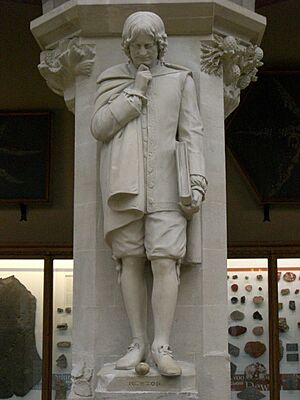
Newton's monument (built in 1731) is in Westminster Abbey. It's near his tomb. The monument shows Newton resting on a stone coffin, with his elbow on his books. His hand points to a scroll with math designs. Above him is a pyramid and a globe showing stars and a comet. A carving below shows small angels using telescopes and prisms.
From 1978 to 1988, Isaac Newton's picture was on the back of the British £1 banknotes. He was shown holding a book, with a telescope, a prism, and a map of the Solar System.
A statue of Isaac Newton, looking at an apple, is at the Oxford University Museum of Natural History. A large bronze statue by Eduardo Paolozzi is in front of the British Library in London. Another bronze statue of Newton stands in the center of Grantham, where he went to school.
Images for kids
-
Newton in 1702 by Godfrey Kneller
-
A 1682 letter from Newton to William Briggs
-
Engraving of Portrait of Newton by John Vanderbank
-
Newton's own copy of Principia with his handwritten notes
-
Isaac Newton in old age in 1712, portrait by Sir James Thornhill
-
Coat of arms used by Sir Isaac Newton
-
Newton's tomb monument in Westminster Abbey by Rysbrack
See also
 In Spanish: Isaac Newton para niños
In Spanish: Isaac Newton para niños



